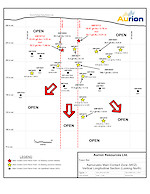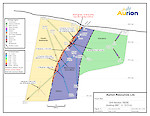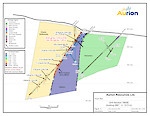Aurion Drills High-Grade, Near Surface Intercepts Extending Mineralization Up-Dip at Aamurusko Main, Including 22.63 g/t Au over 3.53 m
Aurion Resources Ltd. (TSX VENTURE:AU) (“Aurion” or the “Company”) is pleased to announce that it has received assays from 2 holes drilled at the Aamurusko Main prospect on its wholly owned Risti Project in northern Finland. These holes are follow-up to drill results reported on September 19th, 2018 and February 15th, 2019, which included 789 grams per tonne (“g/t”) Au over 2.90 metres (“m”) in drill hole AM18042, 42.28 g/t Au over 4.0 m in drill hole AM19082 and 24.50 g/t Au over 4.75 m in drill hole AM19081.
Highlights:
- Drill hole AM19114 intersected 22.63 g/t Au over 3.53 m from 44.47 m
- Including 52.3 g/t Au over 1.4 m
- Drill hole AM19113 intersected 18.47 g/t Au over 2.76 m from 43.94 m
- Including 93.7 g/t Au over 0.51 m
- Mineralization at Aamurusko Main extended up-dip and continuity indicated over 155 m depth
- To date, at Aamurusko Main, nine of twenty-eight drill holes intersected visible gold mineralization and eleven of twenty-eight drill holes intersected 10 g/t Au or higher
- Mineralization remains open in multiple directions at Aamurusko Main and much of the prospective strike extent between Aamurusko Main and Aamurusko Northwest remains untested
- Drilling is ongoing at both Aamurusko and Launi
- Aurion is fully funded for exploration through 2020
- See table of assays below and click the link to see maps and sections:
Comments
“We are very happy with the follow-up results at Aamurusko Main,” says David Lotan, Chairman of Aurion. “The high-grade intercepts in AM19113 and AM19114 demonstrate up-dip continuity of previously drilled quartz veins and more importantly shows continuity of the mineralized structure along the Aamurusko Main Contact Zone.”
Discussion Aamurusko Main is located 600 to 700 m southeast of the Aamurusko NW target area where several high-grade drill intercepts were previously reported, including 13.31 g/t Au over 19.54 m, 23.41 g/t Au over 11.10 m and 6.84 g/t Au over 19.00 m.
Aamurusko Main is located 600 to 700 m southeast of the Aamurusko NW target area where several high-grade drill intercepts were previously reported, including 13.31 g/t Au over 19.54 m, 23.41 g/t Au over 11.10 m and 6.84 g/t Au over 19.00 m.
The 2019 drill program at Aamurusko Main was designed as a follow-up to the successful drill program from 2018. The drill program in 2018 targeted a faulted east-west trending gabbro-sediment contact now called the Aamurusko Main Contact Zone (MCZ). AM19113 and AM19114 were the first drill holes at Aamurusko Main since the last drill program ended there in February 2019.
Structural analysis of oriented core measurements has indicated that there are multiple orientations of the auriferous quartz veins at Aamurusko Main. Holes AM19113 and AM19114 were drilled to test for a northeast orientation, as found at Aamurusko Northwest. AM19113 and AM19114 intersected significant widths of quartz veins (core lengths of 3.44 m and 3.53 m respectively) with multiple points of visible gold at the MCZ. Both of these quartz vein intercepts exhibit crack-seal textures which are typical for high-grade veins at Aamurusko. Other previously drilled crack-seal textured quartz veins in the MCZ which carried lower amounts of gold can be explained by high variability in the gold distribution (nugget effect).
| Aamurusko Main Contact Zone (MCZ) Drillhole Summary Table | |||||||
| Drill Hole | Azimuth | Dip | From (m) | To (m) | Width (m) | Au g/t | Comments |
| AM19113 | 100.6 | -45.6 | 43.94 | 46.7 | 2.76 | 18.47 | quartz vein intercept is 3.44 m wide (43.94 to 47.38). Lower contact sample is not included |
| including | 43.94 | 44.45 | 0.51 | 93.7 | high concentrations of VG along crack-seal textures in vein near upper contact | ||
| AM19114 | 100.6 | -78.7 | 44.47 | 48 | 3.53 | 22.63 | quartz vein intercept is 3.53 m wide |
| including | 45.5 | 46.9 | 1.4 | 52.3 | high concentrations of VG with minor galena along crack-seal textures in vein | ||
| All widths are core widths. True width is not known at this time. | |||||||
| All assay values are uncut | |||||||
 AM19113: A 3.44 m wide (core length) near surface massive quartz vein was intercepted in the MCZ from 43.94 m to 47.38 m in AM19113 only 25 m vertically below surface. This quartz vein has 62 occurrences of visible gold along with fine tourmaline needles and assayed 18.47 g/t Au over 2.76 m from 43.94 m (the sample at the lower contact was low grade and not included in the composite). The highest- grade interval was 93.7 g/t Au over 0.51 m. The distance between the quartz vein intercept in AM19113 and the deepest intercept (17.06 g/t Au over 1.80 m in AM19075) along the gabbro-sediment contact is 130 m. The total distance along the plane of MCZ mineralization from surface to AM19075 is 155 m. Additional intervals in AM19113 included 4.91 g/t over 0.51 m at 32.59 m and 1.33 g/t over 0.74 m at 39.65 m from gold-bearing quartz veins in the sediments.
AM19113: A 3.44 m wide (core length) near surface massive quartz vein was intercepted in the MCZ from 43.94 m to 47.38 m in AM19113 only 25 m vertically below surface. This quartz vein has 62 occurrences of visible gold along with fine tourmaline needles and assayed 18.47 g/t Au over 2.76 m from 43.94 m (the sample at the lower contact was low grade and not included in the composite). The highest- grade interval was 93.7 g/t Au over 0.51 m. The distance between the quartz vein intercept in AM19113 and the deepest intercept (17.06 g/t Au over 1.80 m in AM19075) along the gabbro-sediment contact is 130 m. The total distance along the plane of MCZ mineralization from surface to AM19075 is 155 m. Additional intervals in AM19113 included 4.91 g/t over 0.51 m at 32.59 m and 1.33 g/t over 0.74 m at 39.65 m from gold-bearing quartz veins in the sediments.
 AM19114: A 3.53 m wide (core length) near surface massive quartz vein was intercepted in the MCZ from 44.47 m to 48.00 m in AM19114, 45 m vertically below surface. This quartz vein has a base metal signature including 0.5% galena with minor amounts of chalcopyrite and sphalerite and assayed 22.63 g/t Au over 3.53 m from 44.47 – 48.00 (the entire quartz vein). Visible gold was noted eighty-six (86) times in the 3.53 m interval. The highest- grade interval was 52.3 g/t Au over 1.40 m. A crack-seal quartz vein which assayed 1.76 g/t Au over 0.56 m at 42.24 m just above the zone was not included in the composite. Previous drilling on this section intersected thick quartz veining at the gabbro-sediment contact in holes AM19091 (5.83 m wide quartz vein) and AM17020 (3.15 m wide quartz vein at contact plus a 7.1 m wide quartz vein immediately downhole). The total distance along the plane of MCZ mineralization from surface to AM17020 is 122 m.
AM19114: A 3.53 m wide (core length) near surface massive quartz vein was intercepted in the MCZ from 44.47 m to 48.00 m in AM19114, 45 m vertically below surface. This quartz vein has a base metal signature including 0.5% galena with minor amounts of chalcopyrite and sphalerite and assayed 22.63 g/t Au over 3.53 m from 44.47 – 48.00 (the entire quartz vein). Visible gold was noted eighty-six (86) times in the 3.53 m interval. The highest- grade interval was 52.3 g/t Au over 1.40 m. A crack-seal quartz vein which assayed 1.76 g/t Au over 0.56 m at 42.24 m just above the zone was not included in the composite. Previous drilling on this section intersected thick quartz veining at the gabbro-sediment contact in holes AM19091 (5.83 m wide quartz vein) and AM17020 (3.15 m wide quartz vein at contact plus a 7.1 m wide quartz vein immediately downhole). The total distance along the plane of MCZ mineralization from surface to AM17020 is 122 m.
Summary
Gold mineralization has been intersected in multiple rock types starting at surface to a depth of 180 m. Mineralization remains open along strike and at depth at both Aamurusko Main and NW. The 600 m distance between Main and NW, and to the east of Main, where numerous high-grade boulders have been discovered, has been virtually untested. The Aamurusko boulder field, comprising 1,210 angular quartz boulders that assayed an average of 25 g/t Au (previously disclosed), is > 1.3 km wide, indicating there are possibly multiple bedrock sources.
Aurion’s exploration program is fully funded through 2020.
Background
The geological setting of the Risti project has many similarities to prolific gold-rich orogenic gold belts globally, specifically the Timmins camp of the Abitibi geological province of Northern Ontario. The Aamurusko zone appears to be underlain by young unconformable clastic rocks (meta-sandstones and conglomerates) of the Kumpu Group. These Kumpu Group conglomerates resemble the Timiskaming conglomerates of the Timmins and Kirkland Lake area of the Abitibi province and occur in a similar geo-tectonic setting (both represent the youngest stratigraphic sequence within their respective belts). The Kumpu Group and the Timiskaming group were deposited in late orogenic extensional basins. They form in relation to major movement along regional faults or deformation zones. In the Abitibi province, many high-grade, multimillion-ounce gold deposits are temporally and spatially associated with the Timiskaming conglomerates (or their equivalents) in close proximity to major regional deformation (fault) zones such as the Porcupine-Destor or Cadillac Lake-Larder Lake deformation zones. The Kumpu Group appears to have been deposited in a similar geological setting adjacent to the Sirkka shear zone, which is a major deformation zone in the Central Lapland Greenstone Belt. Strong alteration including fuchsite, tourmaline, iron carbonate, albite and quartz veining is observed along the entire length of this structure.
Quality Assurance and Quality Control
All samples were delivered to ALS preparation facility in Sodankylä, Finland where sample preparation work was completed. All analytical work was completed at ALS facilities in Loughrea, Ireland and Rosia Montana, Romania. ALS is an internationally accredited lab and are ISO compliant (ISO 9001:2008, ISO/IEC 17025:2005). All samples were analyzed for gold using the Au-AA26 procedure (50g fire assay with AAS finish: Lower Detection Limit 0.01 g/t gold; Upper Limit 100 g/t gold). Any samples that returned over-limit values (>100 g/t gold) or had visual indications of mineralization, such as visible gold or prospective vein intervals were analyzed by Au-SCR24 1kg, Screen Fire Assay Au (0.05-1,000 ppm) by 1kg screen fire assay (50g nominal sample weight). The sample pulp (1kg) is passed through a 100-micron stainless steel screen. Any material remaining on the screen (>100 micron) is retained and analyzed in its entirety by fire assay with gravimetric finish and reported as the Au (+) fraction. The material passing through the screen (<100 micron) is homogenized and two sub-samples are analyzed by fire assay with AAS finish. The average of the two AAS results is taken and reported as the Au (-) fraction result. All three values are used in calculating the combined gold content of the plus and minus fractions. The gold values for both the (+) 100 and (-) 100 micron fractions are reported together with the weight of each fraction as well as the calculated total gold content of the sample. Multi-element analysis (ME-ICP61, four-acid digestion, 35 element ICP-AES) was completed on all samples. Certified standards and blanks were inserted every 20 samples. ALS has its own QA/QC protocol using standards, blanks and duplicates.
This news release has been reviewed and approved by Andrew Hussey, P.Geo., GIS Geologist and Database Manager for Aurion Resources, a Qualified Person as defined by National Instrument 43-101. For more information on these projects please visit our website at www.aurionresources.com.
Forward-Looking Statement
Certain statements contained in this release constitute forward-looking information. These statements relate to future events or future performance. The use of any of the words “could”, “intend”, “expect”, “believe”, “will”, “projected”, “estimated” and similar expressions and statements relating to matters that are not historical facts are intended to identify forward-looking information and are based on the Companies’ current belief or assumptions as to the outcome and timing of such future events. Actual future results may differ materially. The forward-looking information contained in this release is made as of the date hereof and Aurion is not obligated to update or revise any forward‑looking information, whether as a result of new information, future events or otherwise, except as required by applicable securities laws. Because of the risks, uncertainties and assumptions contained herein, investors should not place undue reliance on forward‑looking information. The foregoing statements expressly qualify any forward‑looking information contained herein.
About Aurion Resources Ltd.
Aurion Resources Ltd. (Aurion) is a Canadian exploration company listed on the TSX Venture Exchange (TSX-V:AU). Aurion’s strategy is to generate or acquire early stage precious metals exploration opportunities and advance them through direct exploration by our experienced team or by business partnerships and joint venture arrangements. Aurion’s current focus is exploring on its Flagship Risti and Launi projects, as well as advancing joint venture arrangements with Kinross Gold Corp., B2 Gold Corp., and Strategic Resources Inc. in Finland.
On behalf of the Board of Directors,
David Lotan, Chairman
For further information, please contact:
Mark Santarossa, Vice President, Corporate Development
Cell: (416) 371-1325
Email: msantarossa@aurionresources.ca
Neither the TSX Venture Exchange nor its Regulation Services Provider (as that term is defined in the policies of the TSX Venture Exchange) accepts responsibility for the adequacy or accuracy of this release.
